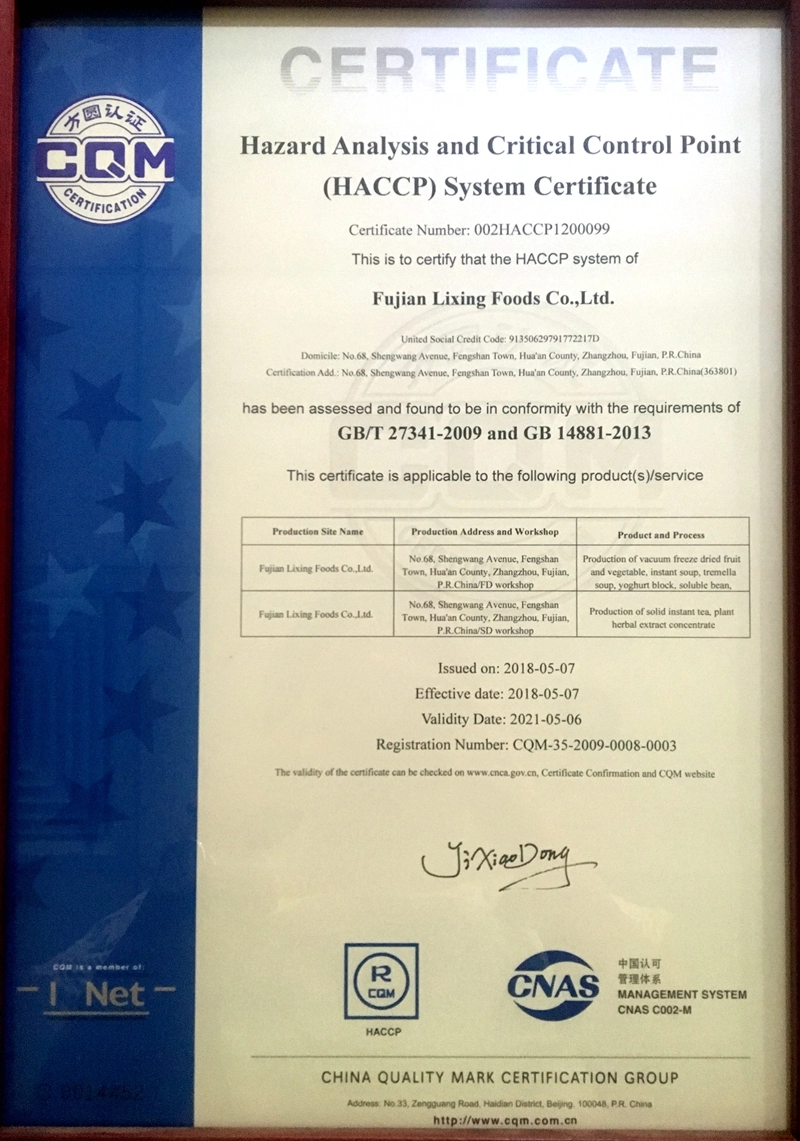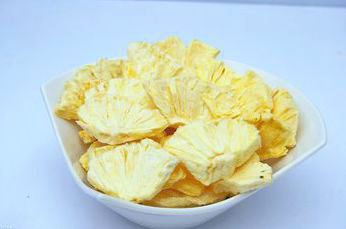| Product Name | Freeze Dried Apple |
| Specification | Slice/cube/powder |
| Material | Apple |
| Packing | Customized |
| Shippment | FOB Xiamen |
| Shelf life | 12 months |
| Storage | In a cool & dry place, avoiding sun exposure |
| MOQ | 100kg |



Our Freeze dried apple advantages
Freeze-dried apples are food products made from fresh apples after slicing, coring, freezing and vacuum drying. The following is a detailed description of freeze-dried apples:
Long-term preservation: Freeze-dried apples have most of the water removed, so they are not easy to deteriorate and can be preserved for a long time to maintain their natural nutrition and taste.
Portable: Freeze-dried apples are lightweight and easy to carry, making them a suitable choice for on-the-go, travelling or office snacks.
Nutrient-rich: Although the water is removed, freeze-dried apples still retain their nutrients such as vitamins, minerals and fibre, which help to boost immunity and maintain health.
Unique taste: Freeze-dried apples have a crunchy, light texture and unique flavour that is more chewy than fresh apples.
Multi-purpose: Freeze-dried apples can be eaten directly or used as an ingredient in a variety of baking, pastries, cereals, salads, yoghurts, juices, etc. to add flavour and nutrients.
NUTRITIONAL VALUE: Freeze-dried apples are rich in vitamin C, fibre and antioxidants, which help to boost immunity, improve digestion and maintain cardiovascular health. In addition, apples contain small amounts of vitamin A, calcium and potassium, among other nutrients.
Production process: The process of making freeze-dried apples includes washing, slicing/core removal, freezing, vacuum drying and packaging of apples. This process aims to retain as much of the apple’s nutrients and flavour as possible, while ensuring the quality and hygiene of the product.
Purchase Precautions: When purchasing freeze-dried apples, you should pay attention to the shelf life and preservation status of the product, and choose reputable brands and suppliers. Also check the ingredient list of the product to ensure that there is no excessive sugar or preservatives added.
How to eat: Freeze-dried apples can be eaten directly or soaked in water and consumed as a fruit bubble tea, or used as ingredients in a variety of baking, pastries, cereals, salads, yoghurts, juices and so on.
Freeze-dried apples undergo a meticulous process starting with washing, slicing, coring, freezing, and finally vacuum drying, ensuring they retain maximum flavor and nutrients. Here’s a detailed exploration of freeze-dried apples:
Long-Term Preservation: By removing most of their water content, freeze-dried apples resist spoilage and can be stored for extended periods while preserving their natural nutrition and taste.
Portable: Lightweight and easy to carry, freeze-dried apples are ideal for snacking on-the-go, during travel, or as office snacks.
Nutrient-Rich: Despite dehydration, freeze-dried apples maintain essential vitamins, minerals, and fiber. These nutrients bolster immunity and support overall health.
Unique Taste: Freeze-dried apples offer a crunchy, light texture with a distinctive flavor that’s more chewy compared to fresh apples.
Multi-Purpose: Enjoy freeze-dried apples straight from the package or use them as ingredients in baking, pastries, cereals, salads, yogurts, juices, and more, enriching both flavor and nutritional content.
Nutritional Value: Rich in vitamin C, fiber, and antioxidants, freeze-dried apples aid in immunity, digestion, and cardiovascular health. They also contain traces of vitamin A, calcium, and potassium.
Production Process: The meticulous production process involves washing, slicing, removing cores, freezing, vacuum drying, and packaging to preserve nutrients and flavor while ensuring product quality and hygiene.
Purchase Tips: Choose freeze-dried apples with a suitable shelf life and ensure they are properly preserved. Opt for reputable brands to avoid excessive sugar or preservatives. Check the ingredient list for transparency.
How to Enjoy: Eat freeze-dried apples directly as a crunchy snack, or rehydrate by soaking in water for use in fruit teas. They also enhance a wide range of recipes including baked goods, cereals, salads, yogurts, and juices, adding both taste and nutrition.
In summary, freeze-dried apples offer a convenient, nutrient-packed alternative to fresh fruit, suitable for diverse culinary uses and appreciated for their prolonged shelf life and natural goodness.



Freeze dried process
Freeze drying rocss 
Certifications






Company Profile
Fujian Lixing Food Co., Ltd.
Fujian Lixing Food Co., Ltd. was founded in 2006, covering an area of 180 acres with a total construction area
of nearly 70000 square meters At present, the total investment is nearly 500 million yuan, with a registered capital
of 80 million yuan.
The company focuses on the application of vacuum freeze-drying (abbreviated as freeze-drying) technology
and the manufacturing of freeze-dried healthy food, committed to creating the world’s most Large freeze-dried
food production base. The company currently has 29 freeze-drying production lines and 6300 square meters of
freeze-drying furnace equipment, with an annual production capacity of Nearly 10000 tons of freeze-dried produc
ts, plant extract powder, and concentrated liquid.

Professional FD foods manufacturer/ FUJIAN Lixing foods Co, Ltd
1.With strong QC team to sure the best product quality.They paid high attention to QC process and make strict have set up a perfect, controllable, guaranteed, traceable QC management system to control the quality from raw material till final products.
2.With a team of R&D which to support new product for all customers. Since 2009, 8% of annual turnover is devoted into R&D, that’s the reason we now have obtained more than 20 patents.
Production line showing
1.Production in strict accordance with the HACCP and GMP international food safety system operating standards
2.Large warehouse with neat product shelf, and temperature and humidity control well. Be sure the long term shelf life





FAQ
1.What are freeze-dried apples?
Freeze-dried apples are food products made from fresh apples that have been sliced, cored, frozen and vacuum-dried.
2.What are the nutritional values of freeze-dried apples?
FD apples are rich in vitamin C, fibre and antioxidants, which help boost immunity, improve digestion and maintain cardiovascular health.
3.What is the difference between freeze-dried and fresh apples?
Freeze-dried apples have most of the water removed so they are easier to store and have a crisper texture, but may have less moisture and a softer texture than fresh apples.
4.What is the shelf life of freeze-dried apples?
Freeze-dried apples usually have a longer shelf life than fresh apples, and can last for several months or even more than a year, as long as they are stored in an airtight, dry environment.
5.How to consume FD apples?
Freeze-dried apples can be consumed directly or as an ingredient in a variety of baking, pastries, cereals, salads, yoghurts, juices, etc. to add flavour and nutrition.
6.Who are freeze-dried apples suitable for?
Freeze-dried apples are usually suitable for most people and are ideal for vegetarians, those with demanding diets and children.
7.What is the production process of FD apples?
The production process of FD apples includes washing, slicing/coring, freezing, vacuum drying and packaging of apples, aiming at preserving the nutrients and flavour of apples.
8.What are the consumption precautions for freeze-dried apples?
Although freeze-dried apples are a healthy food, it is recommended to consume them in moderation as excessive intake may cause digestive discomfort. Please note the preservation status and shelf life of the product when purchasing.
9.Are there any added sugars or preservatives in freeze-dried apples?
In most cases, no additional sugar or preservatives are added to freeze-dried apples, but some products may have a small amount of antioxidants added to maintain colour and freshness.
10.What kinds of food products are freeze-dried apples good for?
Freeze-dried apples can be used as an ingredient in a variety of baking, pastries, cereals, salads, yoghurts, juices, etc. to add flavour and nutrition.











